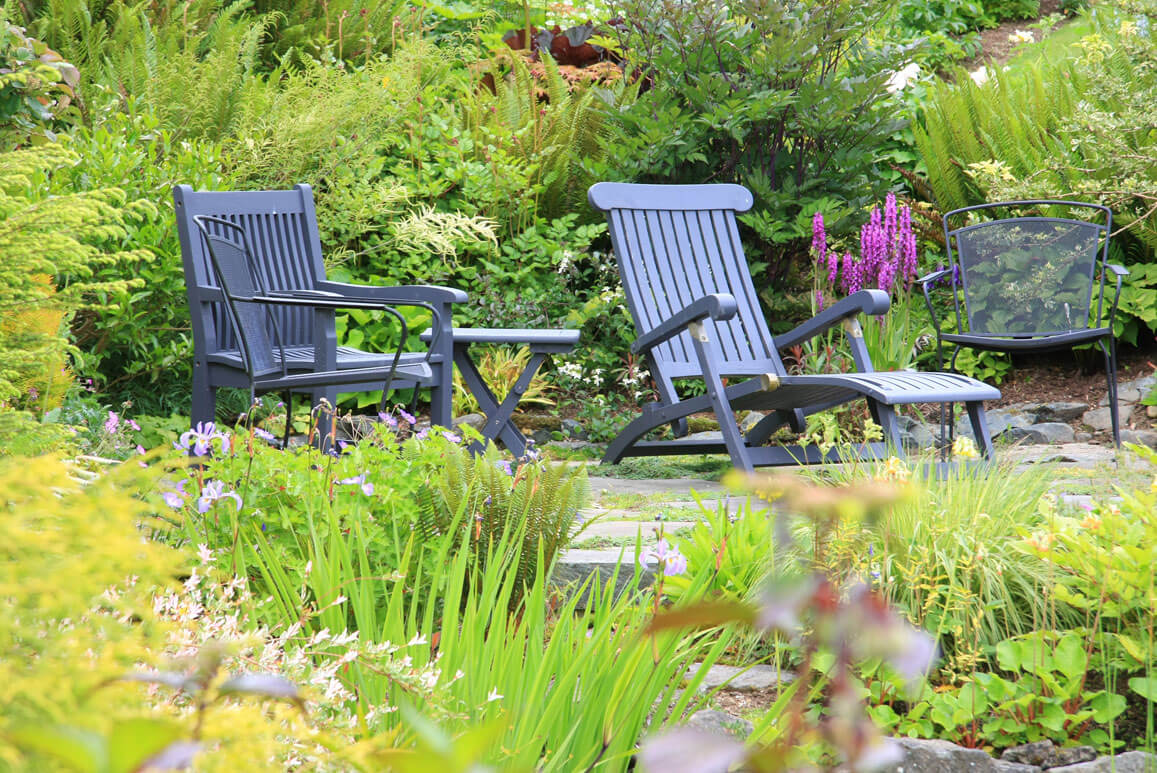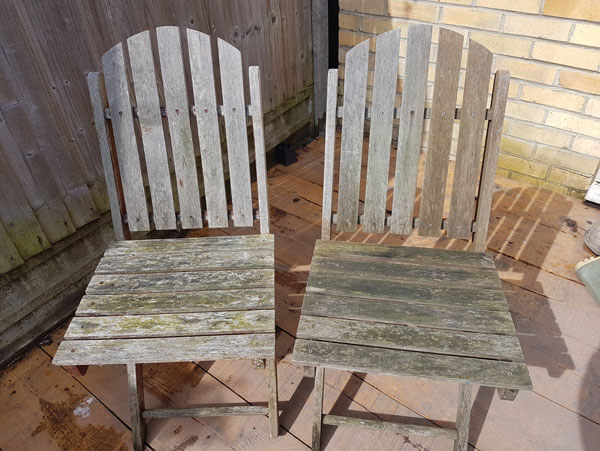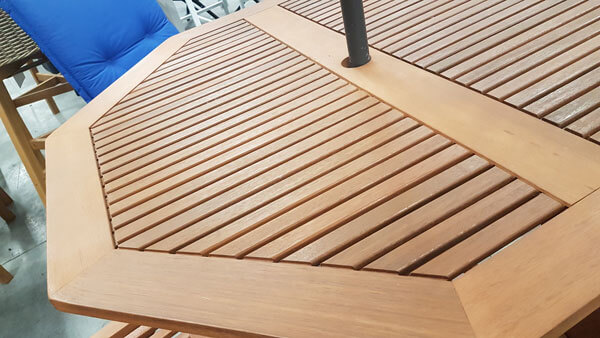Painting garden furniture has become highly fashionable over recent years with the huge range of garden paints on offer. Offering everything from traditional white to trendy shades of grey, soft pastel tones and bright vibrant colours, there is a garden furniture paint for virtually any garden style.

old furniture transformed with a garden furniture paint
Why paint garden furniture?
- Older outdoor furniture that has turned grey or silver can look tired and worn. Painting it with a garden paint is a quicker alternative than trying to restore it to its former, natural appearance
- Garden paints offer a much broader colour spectrum than wood stains and oils. These typically only offer a translucent wood tone or colour.
- Garden paints provide more interesting and contrasting colour options to brighten up and highlight outdoor living spaces
- In addition to adding colour, paints will also protect patio and other outdoor furniture from weathering, extending the life of older furniture and potentially saving on the cost of replacing it. Some brands of garden paint offer guarantees of up to 10 years
Top 5 recommended garden paints
- Cuprinol Garden Shades: A popular water-based garden paint suitable for wooden patio furniture. Available in over 30 colours including shades of green, blue, grey, pink and more
- Ronseal Garden Paint: A water-based garden paint for outdoor furniture, brick, terracotta and metal surfaces.
- Johnstone’s Garden Paint: Provides up to four years protection on most types of garden wood, including tables and chairs and other garden wood. Provides an elegant layer of long-lasting colour without losing the natural grain of the wood. Available in a wide range of colours
- Rust-Oleum Black Mould-Resistant Garden Paint: Ideal for refreshing garden walls and furniture with incredible colour and a flawless matt finish. Weather and mould resistant*, the specialist Garden Paint provides excellent coverage with just one coat, designed to last for up to 6 years – come rain or shine
- HQC Garden Wood Paints: provide weathering and UV protection for garden wood, concrete, stone and brick. Offers exceptional coverage & does a great job of repelling rainwater. HQC paint is particularly good for outdoor furniture by providing long-lasting protection from harsh environmental elements.
How to prepare garden furniture for painting
Before painting garden furniture it is important to ensure that the wood is clean, dry, and free from surface dirt, debris and other wood contaminants. Simply painting over a surface that has not been prepared could result in a poor finish and the possibility of the paint not sticking to the furniture.
Here are some simple steps for bare wood or older, weathered furniture, that will help to produce great results that will last.
- Use a scraper or stiff brush to remove all surface traces of mould, algae and fungi
- Lightly sand all surfaces of the furniture to remove surface, dirt and debris that may have become ingrained in the surface of the wood
- Remove all traces of sanding dust with a tack cloth or slightly dampened cloth
- Ideally, bare wood should be treated with an exterior wood, mould and algae cleaner, to clean the wood and kill off any dormant mould or algae spores in the timber that would simply regrow at a later date
- Degrease the furniture with a cloth dampened with methylated spirit. This is a great way to remove oil, fat or grease stains that could otherwise spoil the finish. This is essential for naturally oily hard wood furniture
- As an option, treat the wood with a wood preservative to protect against mould, algae and insect attack. If using a water-based paint, it is important to use a preservative that does not contain wax, oil or silicon as these will repel water-based paints and prevent them from adhering to the wood
- Stir the paint thoroughly before and periodically during application to ensure a consistent colour finish. Be sure to stir the bottom of the tin as this is where the heavier elements of the paint can sink and collect
- Apply the paint evenly working in the direction of the wood grain
- Allow the first coat to dry in accordance with the manufacturer’s instructions
- Apply a second and any additional coats as required
Outdoors of patio furniture should only be painted after several days of dry, warm weather. Do not paint in the early morning if it is damp, or if rain or frost is expected. Spring or Summer is the recommended time to do this.

Old garden furniture chairs in need of restoration / painting
Always do a test area before starting to paint garden furniture. This is to test colour, adhesion, and the final finish of the paint. Doing a test patch on the underside of the table, chair or bench is a good idea. Always follow the manufacturer’s instructions on the tin or container at all times.
Can all wooden garden furniture be painted?
Any bare wood or freshly sanded garden furniture should be suitable for painting as long as the wood has been properly prepared, and the paint manufacturer’s instructions followed. Exceptions to this are…
- If wood furniture has been oiled and not properly stripped. As most types of garden paint are water-based, they will not stick to wood that has been previously oiled, or treated with a product that contains oil or wax
- Previous coatings of paint or varnish should be stripped and especially so if they have started to crack, flake and peel. Not all paints and varnishes are compatible so painting over an existing paint or varnish may result in a reaction that will ruin the new coating. Doing a test area is strongly advised
- Wooden patio furniture that is heavily soiled with mould, algae, fungi, or other biological growth will prevent the paint from bonding to the surface of the wood. As well as producing a terrible looking finish, chances are that it will start to degrade and flake off in no time. Always treat mould and algae with a suitable wooden garden furniture cleaner before painting
- No amount of painting is going to restore or protect garden furniture that is already rotten. It’s probably best to save the money allocated for paint and use it towards buying and protecting a new wooden patio furniture set

Garden furniture table treated with an oil-based garden furniture stain
Alternatives to painting garden furniture
If you would rather restore or retain the original or natural appearance of wooden garden furniture, it is better to use a clear or coloured garden furniture oil or stain. Here are some helpful resources that will help you to find what you need.
- garden furniture oils nourish and protect wood in a number of ways. They help to keep the wood supple, therefore preventing cracking, splitting, and warping. They also provide excellent weather protection by repelling water. Available in both clear and coloured or stained formulations, they will maintain the colour of newer wooden furniture or can be used to restore the appearance of outdoor furniture that has perhaps turned grey or silver over time
- garden furniture stains are typically used to restore or change the appearance of outside wooden furniture. Garden furniture stains come in two distinct types, those that penetrate into the wood such as coloured wood oils and solvent-based wood stains, and those that coat the surface with a varnish type coating.
For more information on how to restore the natural finish of bare wood or previously oiled garden furniture, read about patio and garden furniture cleaners and restorers here. Once all traces of mould, algae, lichens and other biological growth have been cleaned and removed, outside wooden furniture is ready for re-staining or oiling.
Garden Furniture FAQ’s
Can’t find the answer to your garden furniture care or maintenance project above? See our frequently asked garden furniture questions and answers page, where we try to answer some of the more commonly asked questions relating to garden furniture care, maintenance, and furniture treatments.
